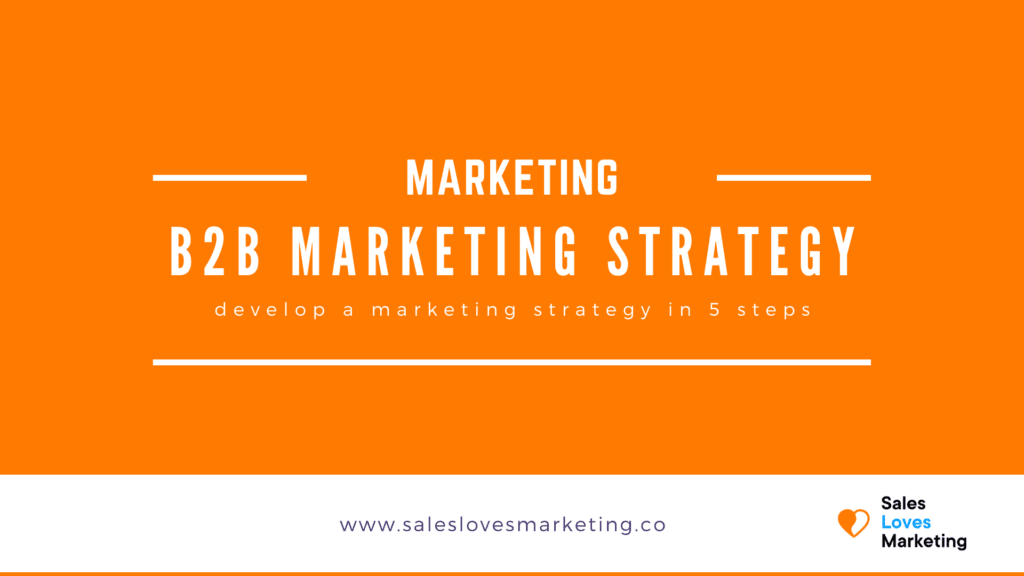Do you want to generate more leads, work together as a team on a common goal and use the right marketing tools to achieve your marketing goals? Then a good B2B marketing strategy is indispensable. As you probably know already, you won’t get there with a lot of separate tools; you need a strategy.
Running the same marketing campaign every year is easy, but you won’t get the most out of your marketing efforts. Certainly not if you are part of a fast-growing company and have big growth ambitions. So, how do you approach implementing a B2B marketing strategy?
We would like to give you a handy step-by-step plan. But before we do that, it’s good to know that you always develop a B2B marketing strategy with specific customers in mind. A strategy is a plan where you take the following into account; your unique value proposition, resources available and your position as a company. For now we will focus us more on the following topics;
- Marketing goals
- Target group
- Marketing strategy
- ROI determination
The following step-by-step plan helps you to develop a good B2B marketing strategy.
Step 1. Determine your position in the market
To set achievable goals, you must know exactly in which market you are active. In a good B2B marketing strategy, you therefore first map out the following:
- Your competitors: what is their position in the market and what are their strengths and weaknesses?
- Your own unique value proposition: what is the added value of your product or service for the customer.
Next to that the above will help you can discover if you as a company are offering something that is needed within the market, you will probably know exactly what kind of focus your message should have. That will be your USP.
Pro tip: Want to go deep, see via these tools where you competitor gets his traffic from and how you score digitally agains them; Ahrefs, SimilarWeb, Ubersuggest or SemRush.
Pro tip: How to spy on your competitors

Step 2. Know your target audience and create buying persona’s
Step two is all about discovering your target group. What do you know about them? Who do you want to buy your product or service? An extensive profile – buyer persona – of your target group will be a great start in your B2B marketing strategy. Even if you will be doing more Account Based Marketing (ABM), it is the best start. It will identify exactly what their struggles ‘pain points’ are and what their interestes are in a very wide angle.
If you want to work out some companies which could be a good fit, you could start with the ones which showed interest in your product/service already by going to the website. A tool like Leadfeeder will help you to do so. It will give you insight what companies have searched within Google (if via an CPC campaign) before finding you.
Go as deep as possible by putting together your buying persona’s. Create even different ones on a personal level; what are their interests, what is their family situation & what kind of media are they getting their information. The deeper you go, the easier the following steps will be.
Pro tip: read our blog on understanding the Marketing Mix
Step 3. Set targets for your B2B marketing strategy
You now got all the information you need to set targets for the strategy. With setting up targets you will always keep the following things in mind:
- You always set goals in consultation with the sales team.
- You connect goals to a time schedule (goals for the following month, quarter, year)
- Goals must be measurable: do your goals also lead to success? And what is the definition of success for your company?
Clear goals help to determine success plus will help you to give you a focus. Creating the goals along with Sales will create co-ownerships which will increase the chance of actually hitting the goals. Once you have determined your KPI’s, make sure you follow them in an analytics tool.
Pro tip: 8 inbound marketing strategies
Step 4. Choose the right tools for your strategy
Your target group and the set goals will help you to define which marketing tools will you should use. A well thought-out mix of marketing tools is the most obvious. A combination of email marketing, social media marketing and paid advertisements on Google is a good example. You could go also for more Growth Hacking tools where you can automate a lot and retrieve a lot of data quickly, always take GDRP in consideration when doing that road.
Our recommendations:
Pro tip: gain more insights about your current website traffic
Step 5. Measure results & gather feedback
First question would be, did you reach your goals set up in step number 3. Wether the answer is yes or no, always make sure to keep a meeting/feedback session with all people involved. Why? This will give you a lot of insights in how you can improve your future campaigns.
Again, choosing the right analytics tools would be crucial so you are always aware of the outcome.

Hubspot offers a free tool where you can create a marketing plan for your next 12months in 10minutes; See it here.
Reading Tip: Understanding the Marketing Mix
